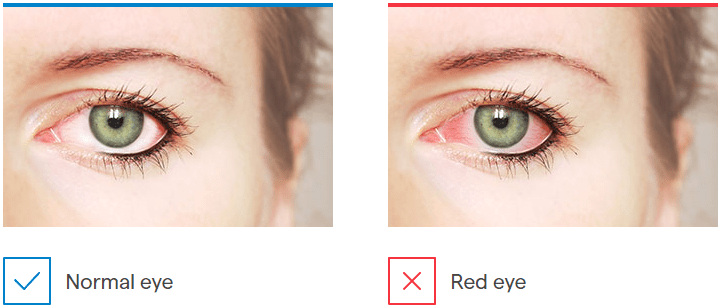Red eye
12 de April de 2022
Red eye might be a symptom of different processes:
- Conjunctivitis: the blood vessels of the conjunctiva –the clear membrane covering the white part of the eyeball– might become inflamed and give the eye a reddish appearance for several reasons: infection (virus or bacteria), allergies (pollen, especially in the spring, or other allergens such as mites) or irritation (cosmetics, chlorine from swimming pools, etc.)
- As well as conjunctivitis, other inflammatory processes that might also lead to red eye are keratitis (corneal inflammation) or uveitis (inflammation of the uvea, the membrane that envelops the interior of the eye and the tissue with most blood vessels in the body).
- Dry eye: because either the tear quantity or quality is insufficient, dry eye means that the surface of the eye is not well lubricated and, therefore, can become inflamed and irritated, and then red. This problem of multiple sources and different degrees of severity affects around 20% of the population, as a result of hormone changes, environmental factors, systemic diseases, other ocular pathologies, etc.
- Incorrect use of contact lenses: soaking lenses for too long, sleeping with them in or poor hygiene when handling them and storing them all lead to the appearance of irritation/infection and, therefore, red eye. You should not swim while wearing contact lenses, due to the presence of micro-organisms in the water such as Acanthamoeba, which could severely infect the eye and produce a corneal ulcer.
- Red eye is one of the characteristic signs of corneal ulcers, lesions that threaten the eyesight if not treated in time and that are generally due to infection.
- Severe attack of glaucoma: although glaucoma is often symptomless until advanced stages of the disease, one of the signs that often accompany a severe attack in patients with a narrow ocular angle is red eye. This is due to the blocking of this angle through which the fluid bathing the inside of the eyeball drains, so its closure leads to a sudden increase in intra-ocular pressure.
- Endophthalmitis: infection of the entire eyeball is one of the most severe causes of red eye, as it jeopardises the well-being of both the eye and eyesight. Where it is exogenous, the infectious agent might enter through an open trauma or intra-ocular surgery (this occurs in less than 1 in every 1,000 surgeries), whereas if it is endogenous, the infection invades the eye through the patient’s blood stream.
- Other possible causes of red eye are different types of trauma (from foreign bodies to corneal erosions, chemical burns or ocular perforations), and the rejection of a corneal transplant.
How to act?
In the event of a wide variety of disorders and problems that could lead to red eye, it is important to assess the other associated symptoms present. Along these lines, vision impairment and pain are the main warning signs that should lead to an emergency visit to the ophthalmologist, as should occasional redness –which is normally relieved by eye drops– that does not disappear after 24 hours.
An ophthalmic examination is essential in determining what is behind red eye and in starting the required treatment, avoiding any possible complications.

Red eye is one of the most frequent reasons for seeing an emergency ophthalmologist and, although it is often due to minor inflammation of the surface of the eye, it could also be a sign of more serious ocular pathologies. It is therefore important to see the ophthalmologist to confirm the diagnosis and assess the degree of severity.
IMO Institute of Ocular Microsurgery
Josep María Lladó, 3
08035 Barcelona
Phone: (+34) 934 000 700
E-mail: international@imo.es
See map on Google Maps
By car
GPS navigator coordinates:
41º 24’ 38” N – 02º 07’ 29” E
Exit 7 of the Ronda de Dalt (mountain side). The clinic has a car park with more than 200 parking spaces.
By bus
Autobus H2: Rotonda de Bellesguard, parada 1540
Autobus 196: Josep Maria Lladó-Bellesguard, parada 3191
Autobuses H2, 123, 196: Ronda de Dalt – Bellesguard, parada 0071
How to arrive at IMO from:
IMO Madrid
C/ Valle de Pinares Llanos, 3
28035 Madrid
Phone: (+34) 910 783 783
See map in Google Maps
Public transport
Metro Lacoma (líne 7)
Autobuses:
- Lines 49 & 64, stop “Senda del Infante”
- Line N21, stop “Metro Lacoma”
Timetables
Patient care:
Monday to Friday, 8 a.m. to 9 p.m.
IMO Andorra
Av. de les Nacions Unides, 17
AD700 Escaldes-Engordany, Andorra
Phone: (+376) 688 55 44
See map in Google Maps
IMO Manresa
C/ Carrasco i Formiguera, 33 (Baixos)
08242 – Manresa
Tel: (+34) 938 749 160
See map in Google Maps
Public transport
FGC. Line R5 & R50 direction Manresa. Station/Stop: Baixador de Manresa
Timetables
Monday to Friday, 09:00 A.M – 07:00 PM




